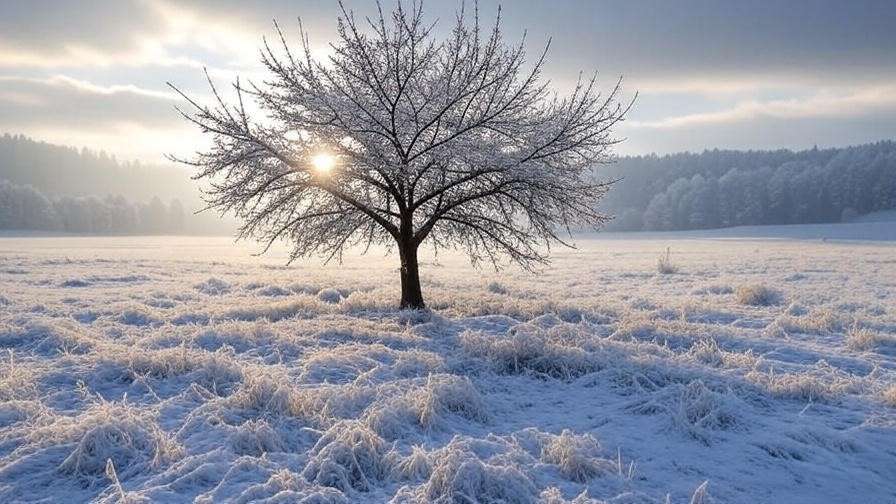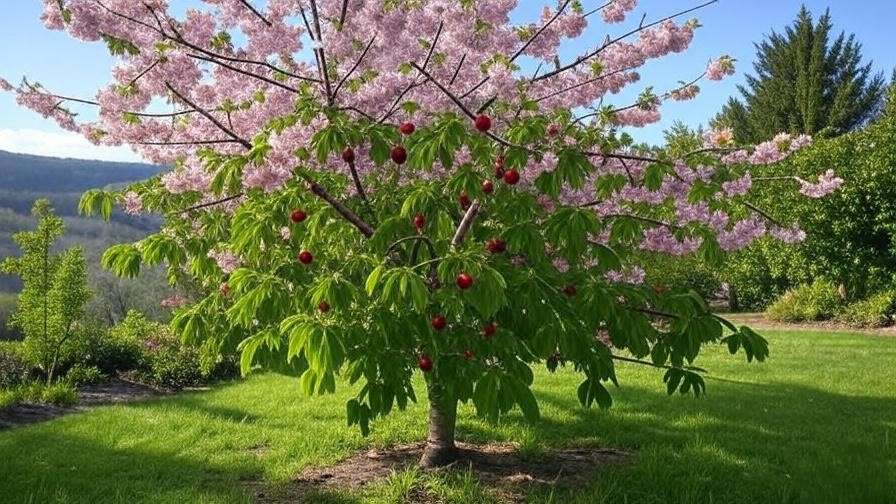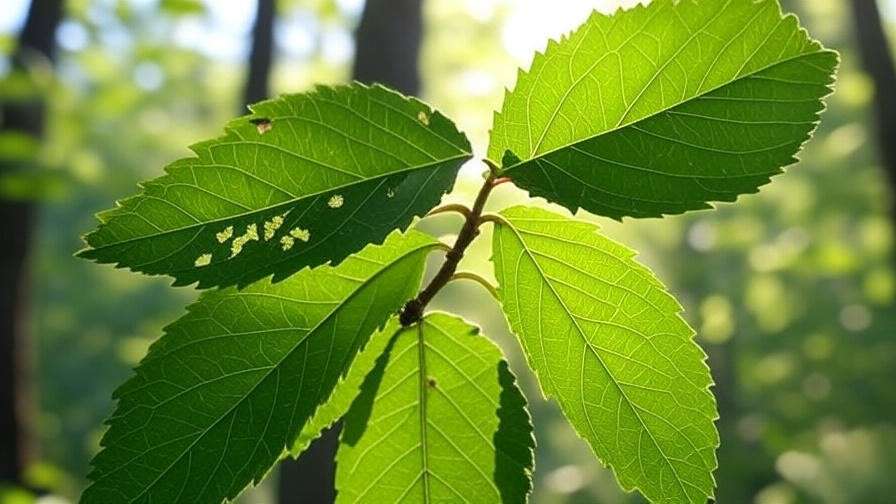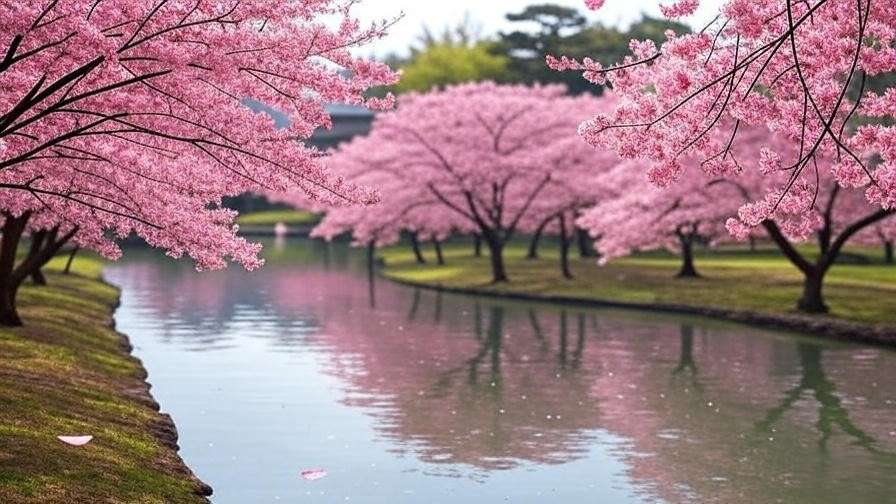Imagine planting a cherry tree with dreams of juicy, homegrown cherries, only to watch it struggle because it’s not suited to your climate. It’s a heartbreak many gardeners face, but it’s entirely avoidable! Choosing The Best Cherry Tree Varieties for Different Climates is the key to a thriving garden and bountiful harvests. Whether you’re in a frosty northern region, a temperate middle zone, or a sun-soaked southern climate, this guide will help you select the perfect cherry tree for your environment. Backed by insights from horticulturists with decades of experience and research from leading agricultural institutions, this article offers a comprehensive roadmap to growing healthy cherry trees. From understanding climate zones to mastering care techniques, you’ll find everything you need to succeed. Let’s dive in and make your cherry tree dreams blossom! 🍒
H2: Understanding Cherry Trees and Climate Needs 🌍
Cherry trees are beloved for their stunning spring blossoms and delicious fruit, but their success hinges on one critical factor: climate compatibility. Temperature, chill hours, humidity, and soil conditions all play a role in determining whether a cherry tree will thrive or falter. By choosing varieties tailored to your region, you can ensure vibrant growth and abundant yields.
H3: What Makes Cherry Trees Climate-Sensitive? 🍒
Cherry trees are sensitive to climate because they require specific conditions to complete their growth cycle. For example, most cherry trees need a certain number of chill hours—hours below 45°F (7°C)—to break dormancy and produce fruit. Too few chill hours in warm climates or extreme cold in harsh winters can disrupt this process. Additionally, humidity levels affect disease susceptibility, while soil drainage impacts root health.
There are two main types of cherry trees: sweet cherries (Prunus avium) and sour cherries (Prunus cerasus). Sweet cherries, like the popular Bing variety, prefer milder climates and are prized for fresh eating. Sour cherries, such as Montmorency, are hardier and better suited to colder regions, often used for baking and preserves. Understanding these differences is crucial for selecting the right tree for your climate.
H3: Overview of USDA Hardiness Zones and Cherry Trees 🗺️
The USDA Hardiness Zone system divides the United States into 13 zones based on average annual minimum winter temperatures. These zones help gardeners choose plants suited to their local climate. For cherry trees, zones 3–10 are relevant, with specific varieties thriving in different ranges. Below is a quick-reference table to guide your selection:
| USDA Zone | Temperature Range (°F) | Recommended Cherry Types |
|---|---|---|
| Zones 3–5 | -40 to -10 | Sour cherries (e.g., Montmorency, North Star) |
| Zones 6–8 | -10 to 20 | Sweet and sour cherries (e.g., Bing, Stella) |
| Zones 9–10 | 20 to 40 | Low-chill sweet cherries (e.g., Minnie Royal) |
Matching your tree to your USDA zone ensures it can withstand local winters and produce fruit reliably. Check your zone using the USDA’s online map or consult your local extension service for precise data.
H2: The Best Cherry Tree Varieties for Cold Climates ❄️
For gardeners in colder regions (USDA Zones 3–5), sour cherry varieties are the go-to choice due to their exceptional cold hardiness. These trees thrive in areas with harsh winters, such as the Upper Midwest or New England, and produce tart, flavorful fruit perfect for culinary creations.

H3: Top Picks for Zones 3–5 🧊🌳
Here are three standout sour cherry varieties for cold climates:
- Montmorency: The gold standard for sour cherries, Montmorency is prized for its bright red fruit and tangy flavor. It requires 700–900 chill hours and is hardy to Zone 4. Ideal for pies, jams, and preserves, this variety is a favorite among home gardeners and commercial orchards alike.
- North Star: A dwarf variety perfect for small gardens, North Star is hardy to Zone 4 and needs about 800 chill hours. Its compact size (8–10 feet tall) makes it easy to manage, and its juicy, tart cherries are excellent for baking.
- Meteor: Another dwarf sour cherry, Meteor is hardy to Zone 3 and requires 800–1000 chill hours. Its large, bright red fruit is versatile for cooking and freezing.
Expert Tip: Sour cherries are naturally more cold-tolerant than sweet cherries, making them ideal for regions with long, frigid winters. Their fruit is also less prone to cracking in wet conditions, a common issue in colder, humid climates.
H3: Care Tips for Cold-Climate Cherry Trees 🌬️
Growing cherry trees in cold climates requires extra attention to protect against frost and harsh conditions. Here are key care tips:
- Pruning: Prune in late winter to remove dead or damaged branches and improve air circulation. This reduces the risk of frost-related diseases like bacterial canker.
- Mulching: Apply a 3–4-inch layer of organic mulch (e.g., wood chips or straw) around the tree’s base to insulate roots and retain moisture. Keep mulch 2 inches from the trunk to prevent rot.
- Winter Protection: Wrap young trees with burlap or tree guards to shield them from wind and frost. In Zone 3, consider planting in a sheltered location to minimize exposure.
Case Study: In Michigan (Zone 4), a family orchard successfully grows Montmorency cherries by planting on a south-facing slope to maximize sunlight and using windbreaks to reduce winter damage. Their annual yield supplies local markets with fresh and preserved cherries, showcasing the potential of cold-climate varieties.
H2: The Best Cherry Tree Varieties for Temperate Climates 🌞
Temperate climates (USDA Zones 6–8) offer a sweet spot for growing both sweet and sour cherry trees. These regions, including parts of the Pacific Northwest and Mid-Atlantic, provide moderate winters and warm summers ideal for a wide range of varieties.

H3: Top Picks for Zones 6–8 🌿🍒
Here are three top varieties for temperate climates:
- Bing: The iconic sweet cherry, Bing produces large, dark red fruit with a rich, sweet flavor. Hardy to Zone 5, it requires 700–800 chill hours and thrives in areas like Washington State.
- Rainier: Known for its stunning yellow-and-red blush, Rainier is a sweet cherry with a delicate, sweet-tart flavor. It’s hardy to Zone 5 and needs 700 chill hours.
- Stella: A self-fertile sweet cherry, Stella is perfect for small gardens. Hardy to Zone 5, it requires 600–800 chill hours and produces juicy, dark red fruit.
| Variety | Fruit Size | Flavor | Harvest Time |
|---|---|---|---|
| Bing | Large | Sweet | Mid-June |
| Rainier | Medium-Large | Sweet-Tart | Late June |
| Stella | Medium | Sweet | Early July |
H3: Care Tips for Temperate-Climate Cherry Trees 🌼
Temperate climates offer flexibility, but proper care ensures optimal growth:
- Watering: Provide 1–2 inches of water weekly during the growing season, especially during fruit development. Use drip irrigation to maintain consistent moisture.
- Pest Management: Protect fruit from birds with netting and monitor for pests like aphids or cherry fruit flies. Organic sprays, such as neem oil, can help.
- Fertilization: Apply a balanced fertilizer (e.g., 10-10-10) in early spring to support growth. Avoid over-fertilizing, which can lead to excessive foliage and reduced fruit.
Expert Insight: A horticulturist from Oregon State University recommends regular soil testing in Zone 7 to ensure proper pH (6.0–6.5) for sweet cherries like Bing, as imbalances can reduce fruit quality.
H2: The Best Cherry Tree Varieties for Warm Climates ☀️
For gardeners in warm climates (USDA Zones 9–10), growing cherry trees can seem challenging due to low chill hours and intense heat. However, low-chill varieties make it possible to enjoy homegrown cherries in regions like Southern California, Florida, or coastal areas. These varieties are bred to thrive with minimal winter chilling, ensuring fruit production even in warmer climates.

H3: Top Picks for Zones 9–10 🌴
Here are three exceptional low-chill cherry varieties for warm climates:
- Minnie Royal: A sweet cherry with vibrant red fruit, Minnie Royal requires only 200–300 chill hours and is hardy to Zone 9. Its compact size (10–12 feet) makes it ideal for smaller gardens, and its sweet, firm fruit is perfect for fresh eating.
- Royal Lee: A companion to Minnie Royal, this sweet cherry also needs 200–300 chill hours and is hardy to Zone 9. It produces deep red, juicy cherries and is often planted alongside Minnie Royal for cross-pollination.
- Lapins: A self-fertile sweet cherry, Lapins requires 400–500 chill hours and is hardy to Zone 9. Its large, dark red fruit is sweet and resistant to cracking, making it a reliable choice for warm regions.
Real-World Example: A gardener in Southern California (Zone 10) successfully grows Minnie Royal and Royal Lee cherries in a backyard orchard by planting them in raised beds with excellent drainage. Their annual harvest supplies fresh cherries for their family and neighbors, proving that warm climates can support cherry cultivation with the right varieties.
H3: Care Tips for Warm-Climate Cherry Trees 🔥
Warm climates demand specific care strategies to protect cherry trees from heat and drought:
- Shade and Heat Management: Provide partial shade during the hottest part of the day, especially for young trees. Use shade cloth or plant near taller trees to reduce heat stress.
- Soil and Drainage: Ensure well-draining, loamy soil with a pH of 6.0–6.5. Add organic matter like compost to improve soil structure in sandy or clay-heavy soils.
- Watering: Water deeply 1–2 times per week, adjusting for rainfall. Mulch with organic material to retain moisture and keep roots cool.
FAQ: Can You Really Grow Cherries in Hot Climates?
Yes, with low-chill varieties like Minnie Royal and Royal Lee, cherries can thrive in Zones 9–10. The key is selecting trees with low chill-hour requirements (200–500 hours) and providing extra care, such as consistent watering and protection from extreme heat. Pairing with a pollinator variety, if needed, boosts fruit production.
H2: Key Factors to Consider When Choosing a Cherry Tree 🌱
Selecting the right cherry tree involves more than just picking a variety you like. Factors like chill hours, pollination needs, and site conditions play a critical role in ensuring long-term success. Here’s what to consider before planting.
H3: Chill Hours Explained ⏰
Chill hours refer to the cumulative hours below 45°F (7°C) during winter that a cherry tree needs to break dormancy and produce fruit. Without sufficient chill hours, trees may fail to bloom or fruit properly. Here’s a quick-reference chart for popular varieties:
| Variety | Chill Hours | USDA Zones |
|---|---|---|
| Montmorency | 700–900 | 4–7 |
| North Star | 800–1000 | 3–7 |
| Bing | 700–800 | 5–8 |
| Stella | 600–800 | 5–8 |
| Minnie Royal | 200–300 | 9–10 |
| Lapins | 400–500 | 9–10 |
Check your local chill hours using weather data from your regional agricultural extension service or online chill-hour calculators.
H3: Pollination Needs for Cherry Trees 🐝
Cherry trees vary in their pollination requirements, which can impact fruit production:
- Self-Fertile Varieties: Trees like Stella and Lapins don’t require a second tree for pollination, making them ideal for small gardens or solitary planting.
- Cross-Pollinating Varieties: Many sweet cherries, like Bing and Rainier, need a compatible pollinator tree nearby (within 50 feet) to produce fruit. For example, Black Tartarian is a great pollinator for Bing.
Tip: When planting cross-pollinating varieties, ensure bloom times overlap. Check variety descriptions or consult a local nursery to confirm compatibility.
H3: Soil, Sunlight, and Space Requirements 🌞🌍
Cherry trees thrive under specific conditions:
- Soil: Aim for well-draining, loamy soil with a pH of 6.0–6.5. Test your soil and amend with compost or sulfur if needed.
- Sunlight: Provide at least 6–8 hours of direct sunlight daily for optimal growth and fruit production.
- Space: Standard cherry trees need 20–25 feet of space, while dwarf varieties require 8–12 feet. Ensure proper spacing to prevent overcrowding and promote air circulation.
Expert Insight: A common mistake is planting cherry trees in poorly drained soil, leading to root rot. Always test drainage by digging a 12-inch hole, filling it with water, and ensuring it drains within 2–3 hours.
H2: Step-by-Step Guide to Planting and Caring for Cherry Trees 🌳
Proper planting and ongoing care are essential for healthy cherry trees. Follow these steps to set your tree up for success and ensure years of fruitful harvests.

H3: Planting Your Cherry Tree 🕳️
- Choose the Right Time: Plant in early spring in cold climates or late fall in warm climates to allow roots to establish.
- Select a Site: Pick a sunny, well-drained location with good air circulation. Avoid low-lying areas prone to frost pockets.
- Prepare the Soil: Dig a hole twice as wide and as deep as the root ball. Mix native soil with compost for nutrient-rich planting.
- Plant the Tree: Place the tree in the hole, ensuring the graft union (if present) is 2–3 inches above the soil line. Backfill and water thoroughly.
- Mulch and Stake: Apply a 3-inch layer of mulch around the base and stake young trees to protect against wind.
Checklist for First-Time Gardeners:
- ☑ Confirm USDA zone and chill hours
- ☑ Test soil pH and drainage
- ☑ Ensure 6–8 hours of sunlight
- ☑ Space trees appropriately
H3: Ongoing Care and Maintenance 🧑🌾
- Watering: Provide 1–2 inches of water weekly during the growing season, adjusting for rainfall. Deep, infrequent watering encourages strong roots.
- Fertilizing: Apply a balanced fertilizer (e.g., 10-10-10) in early spring, following package instructions. Avoid fertilizing after mid-summer to prevent late-season growth.
- Pruning: Prune annually in late winter to remove dead, damaged, or crossing branches. Shape the tree to maintain an open canopy for air circulation.
- Disease Prevention: Monitor for common diseases like brown rot or powdery mildew. Use organic fungicides and remove infected debris promptly.
Seasonal Care Calendar:
- Spring: Fertilize, prune, and monitor for pests.
- Summer: Water consistently and protect fruit from birds.
- Fall: Clean up fallen leaves and apply mulch.
- Winter: Protect young trees from cold and rodents.
H2: Common Challenges and Solutions for Growing Cherry Trees 🚨
Even with the best planning, cherry trees can face challenges. Here are common issues and expert solutions:
H3: Pest and Disease Management 🐞
- Birds: Birds love cherries, especially sweet varieties. Use bird netting or reflective tape to deter them.
- Cherry Fruit Fly: These pests lay eggs in developing fruit. Apply organic insecticides like spinosad during early fruit development.
- Brown Rot: A fungal disease causing fruit rot. Improve air circulation through pruning and apply sulfur-based fungicides preventatively.

Solution Example: A gardener in Zone 6 used bird netting and weekly inspections to reduce fruit loss by 80%, ensuring a healthy Bing cherry harvest.
H3: Environmental Stress 🌧️
- Frost Damage: Late spring frosts can harm blossoms. Cover trees with frost cloth during cold snaps or plant late-blooming varieties like Stella.
- Heat Stress: In warm climates, heat can stress trees. Provide afternoon shade and maintain consistent watering to reduce leaf scorch.
- Cracked Fruit: Heavy rain during ripening can cause fruit to split. Choose crack-resistant varieties like Lapins and ensure good drainage.
H2: FAQs About Growing Cherry Trees ❓
Q: How long does it take for a cherry tree to bear fruit?
A: Most cherry trees produce fruit 3–5 years after planting, with dwarf varieties often fruiting sooner. Proper care accelerates this timeline.
Q: Can I grow cherries in a container?
A: Yes, dwarf varieties like North Star or Stella are ideal for containers. Use a large pot (20+ gallons) with well-draining soil and ensure adequate sunlight.
Q: What’s the best time to harvest cherries?
A: Harvest when fruit is fully colored and slightly soft to the touch. Sweet cherries are typically harvested in June–July, while sour cherries ripen slightly later.
H2: Conclusion: Your Path to a Thriving Cherry Tree Garden 🌸
Growing cherry trees is a rewarding journey when you choose The Best Cherry Tree Varieties for Different Climates. Whether you’re savoring sweet Bing cherries in a temperate Zone 7 garden or harvesting tart Montmorency cherries in a chilly Zone 4 orchard, the right variety and care make all the difference. By understanding your climate, matching trees to your USDA zone, and following expert care tips, you can enjoy stunning blossoms and delicious fruit for years to come. Start planning your cherry tree garden today, and let your backyard bloom with beauty and flavor! 🍒🌳













